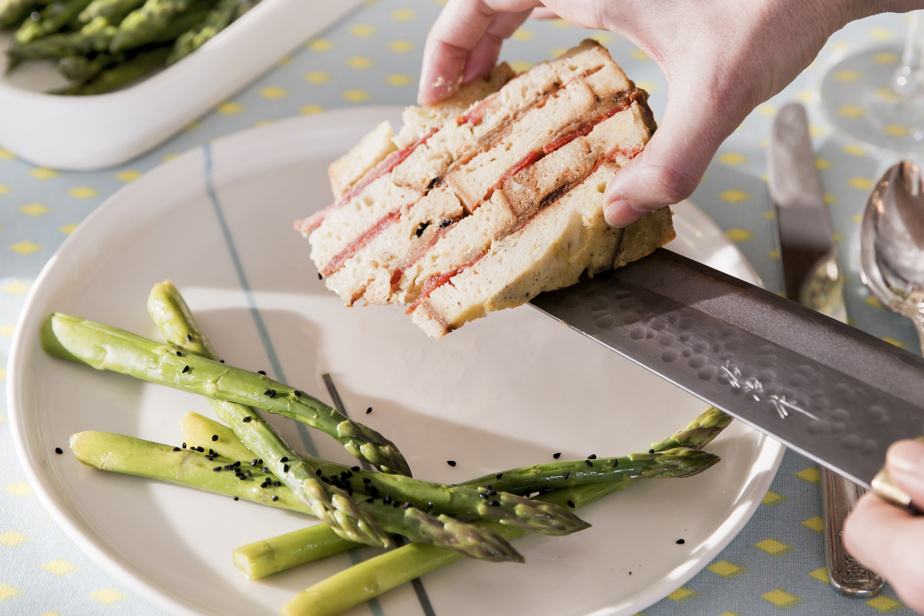Just before the weekend, all readers who cook ask themselves this eternal question: what are we going to eat? To inspire you, The Press suggests a recipe that will make your mouth water.
Typically, a panade does not contain eggs, unlike the strata. In his book, Zuni Cafe, Judy Rodgers even specifies that a panade made with water (rather than milk or broth) is called acquacotta. This one is more like a soup than a gratin, however. Let’s not be too purist! The following recipe contains cream and eggs, for a firm hold.
Serves 6-8 as a main course, 8-10 as a side dish
Ingredients
- 5-6 tomatoes on ripe vines
- 1 L of 35% cream
- 5 eggs
- 12 g salt (1 tsp)
- 2 g ground pepper
- 2 cups sliced onions
- 1 packet of fresh basil
- 100 g grated parmesan (about 1 cup lightly packed cheese)
- 2-3 tbsp. tablespoon of olive oil
- 2 cloves of garlic, chopped
- 1 loaf of sliced sourdough bread (like Bâtard Moulin des Cèdres)
Preparation
- Sauté the onions until caramelized. Set aside and let cool.
- In a mortar or food processor, place the basil, 50 g of parmesan, garlic and olive oil, then puree. Pour into a large bowl.
- Add the cream, eggs, salt and pepper to the pistou. Mix well using a whisk.
- Preheat the oven to 150°C (300°F).
- Line the bottom of an enameled cast iron casserole dish (3.5 L capacity) with parchment paper to make it easier to unmold the cooled panade. (Skip this step if serving the panade immediately after cooking. It simply won’t come out of the mold. Serve with a spoon!)
- Dip the slices of bread in the “pistou” mixture (like for French toast) and place a layer in the bottom of the casserole dish. You may need to trim some slices.
- Make 4-5 mm thick tomato slices and place a layer on the bread. Salt and pepper the tomatoes.
- Place a thin layer of caramelized onions on top of the tomatoes and sprinkle with a little parmesan.
- Repeat these steps another time, finishing with the parmesan.
- Pour a little of the egg-pistou mixture onto the layers of bread. Make sure the bread is well soaked but not soggy.
- Continue to alternate the ingredients following the same sequence (bread, tomatoes, salt-pepper, onions, parmesan). After each double series, pour more egg-pistou mixture onto the layers of bread. The more carefully these steps are done, the more impressive the final effect when slicing will be.
- When all the layers are finished (the mixture may come under the edge or even overflow a little), add as much egg-pistou mixture as possible. The more there are, the softer the panade will be. For a drier panade, add less liquid.
- Cover the casserole dish with aluminum foil, dull side out, pulling the paper in the center upwards to prevent it from touching the panade.
- Bake the panade for 120 to 135 minutes or until the panade is set and the liquid seems all absorbed.
- If the panade is served immediately, slice straight from the casserole dish and serve. If the panade is prepared in advance, let cool completely after cooking. Then cover and refrigerate overnight. The next day, run a spatula over the sides of the casserole dish to facilitate unmolding. Turn the panade over onto a board or large platter. Slice and place on a plate. Pour a spoonful of 35% cream on top then reheat in an oven at 150-165°C (300-325°F).
- It is also possible to prepare the panade a day in advance, stopping before the baking stage. Keep refrigerated. When ready to cook, be sure to preheat the oven to 150°C (300°F) and add 30 to 40 minutes to the time in step 14 to ensure complete cooking.
Published on lapresse.ca on April 15, 2017.
